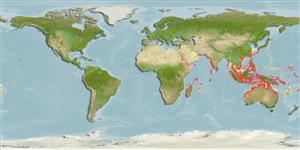Environment: milieu / climate zone / djupintervall / distribution range
Ekologi
marina; brackvatten revassocierade; djupintervall 0 - 20 m (Ref. 127989). Subtropical; 32°N - 33°S, 28°E - 178°W
Indo-West Pacific: Red Sea and East Africa to southern Japan, New Guinea and Arafura Sea (Ref. 9819). Reported from Vanuatu (Ref. 13300). Migrated to the Mediterranean from the Red Sea via the Suez Canal (Ref. 5385).
Size / Vikt / Age
Könsmognad: Lm ? range ? - ? cm
Max length : 30.0 cm TL hane/ej könsbestämd; (Ref. 30573)
Taggstrålar i ryggfenan (totalt) : 12 - 13; Mjukstrålar i ryggfenan (totalt) : 8 - 11; Taggstrålar i analfenan: 3; Mjukstrålar i analfenan: 9 - 11. Generally silver in color, with 4-6 dark horizontal lines; a black blotch behind head and below dorsal origin and another in front of dorsal fin may be present; caudal fin pale or slightly dusky (Ref. 4327).
Body shape (shape guide): fusiform / normal.
Are coastal species often found in brackish waters; common in estuaries. They croak when taken from the water. Usually forming schools. Juveniles in seagrass beds and in mangrove bays (Ref. 48635). Feed on small fishes and invertebrates. Eggs are guarded and fanned by the male parent (Ref. 205). Maximum depth reported taken from Ref. 127989.
Life cycle and mating behavior
Könsmognad | Reproduktion | Lek | Ägg | Fecundity | Larver
Eggs are guarded and fanned by the male parent (Ref. 205).
Paxton, J.R., D.F. Hoese, G.R. Allen and J.E. Hanley, 1989. Pisces. Petromyzontidae to Carangidae. Zoological Catalogue of Australia, Vol. 7. Australian Government Publishing Service, Canberra, 665 p. (Ref. 7300)
IUCN Red List Status (Ref. 130435: Version 2025-1)
Threat to humans
Harmless
Human uses
Fiskeri: mindre kommeriell
Verktyg
Special reports
Download XML
Internet-källor
Estimates based on models
Preferred temperature (Ref.
123201): 24.4 - 29, mean 28 °C (based on 1262 cells).
Phylogenetic diversity index (Ref.
82804): PD
50 = 0.6250 [Uniqueness, from 0.5 = low to 2.0 = high].
Bayesian length-weight: a=0.01047 (0.00661 - 0.01659), b=3.02 (2.88 - 3.16), in cm total length, based on LWR estimates for this species & (Sub)family-body (Ref.
93245).
Trofisk nivå (Ref.
69278): 3.6 ±0.4 se; based on diet studies.
Resiliens (Ref.
120179): Mellan, lägsta populationsfördubblingstid 1,4-4,4 år (Preliminary K or Fecundity.).
Fishing Vulnerability (Ref.
59153): Low vulnerability (20 of 100).
🛈
Climate Vulnerability (Ref.
125649): Moderate to high vulnerability (50 of 100).
🛈
Nutrients (Ref.
124155): Calcium = 34.7 [16.7, 81.9] mg/100g; Iron = 0.604 [0.350, 0.984] mg/100g; Protein = 20.1 [19.1, 21.1] %; Omega3 = 0.256 [0.154, 0.426] g/100g; Selenium = 14.2 [6.9, 26.8] μg/100g; VitaminA = 50.8 [15.9, 162.8] μg/100g; Zinc = 0.954 [0.631, 1.405] mg/100g (wet weight);
